 United States of America (1984-1987)
United States of America (1984-1987)
MBT – Models Only
In 1984, the US military was considering the problems connected with a new range of vehicles, such as the new M1 Abrams main battle tank and M2 Bradley Infantry Fighting Vehicle (IFV). As part of the evaluation of trends in future vehicles, a commission looked into the potential for electric drive systems for a 40-ton (36.3 tonne) (tank) and 19.5-ton (17.7 tonne) (APC/IFV) platform.
The US Army’s Tank Automotive Command (TACOM) issued a contract to General Dynamics Land Systems for this project – to evaluate existing electric drive technologies to use in future vehicles. This was contract number DAAE07-84-C-RO16 divided into 2 phases – a third phase was added later under contract modification P00006.
The goal was roughly that of evaluating the ‘new’ (electric drive for vehicles predates armored vehicle) technology available across a variety of platforms for what it may offer for further development. What it actually generated was the realization that electric-drive fighting vehicles were not only possible but had some valuable features worth exploring, especially with regards to a series of heavy IFV platforms. However, like so many other studies, this work faded away and the design work was abandoned. To this day, in 2020, the M1 Abrams remains in service with a conventional power plant along with numerous other armored vehicles in the US inventory. Despite the billions of dollars spent, to date, the US military has yet to capitalize on the potential of electric-drive vehicles.
Phase I: A survey of existing technology (document JU-84-04057-002)
Phase II: Generation of concept vehicles with electric drive
Phase III: A parametric study and evaluation with selection of 3 recommended concepts for further consideration
General Dynamics had actually been looking into the potential of electric drive systems as early as 1981, producing electric-drive concept vehicles for various other vehicle projects. It also had possession of a 8 x 8 wheeled, 15-ton (13.6 tonne) Electric Vehicle Test Bed (EVTB) it had paid for itself in order to test and validate electric drive.


General Dynamics EVTB (also known as the Advanced Hybrid Electric Drive vehicle). Source: DiSante and Paschen, and Khalil
The timetable for the project was for Phase I to be concluded by the end of 1984. In the end, the report on this phase was finished in July 1984 and then published in January 1985. By this time the second phase was already underway with an expected conclusion date in the latter half of 1985 to be followed by another report and, starting in the middle of 1986, Phase III running through into the start of 1987.
Why Electric Drive?
The potential of electrical drive systems was experimented with on tanks as far back as WW1. An electrical transmission offered the designer a significant freeing up of the internal layout of an armored vehicle, as the drive motors did not have to be next to the engine, and the ability to deliver continuous, reliable power in preference to mechanical systems. This is primarily because an electrical drive system has far fewer moving parts and bearing surfaces than a mechanical system. There are also major advantages, not the least of which being volume. An electrical system could be smaller than the equivalent mechanical system and smaller volume meant more internal volume in a vehicle for other things and/or a reduction in the amount which needed to be protected by armor – that means less weight too. Electrical transmissions are also quieter due to the absence of gearing and driveshafts and offer the not insignificant potential to provide electrical power for the vehicle’s systems.
Study Concepts
Some 38 possible concepts across the 19.5 (17.7 tonne) and 40-ton (36.3 tonne) vehicles were considered over four basic vehicle considerations. Plans from various companies and one university submitted concept plans for the program namely: Westinghouse, ACEC (Ateliers de Constructions Electriques de Charleroi), Unique Mobility, Garrett, Jarret, and the University of Michigan. All of the options were to consider a scheme for a baseline vehicle.


Baseline 40-ton electric drive vehicle. Source: GDLS
Baseline Vehicle Description
The baseline vehicle for the EDMBT was very similar in external hull layout to the M1 Abrams, with the automotive elements placed under a raised engine deck at the back of the tank. It had a relatively conventional external shape except that all of the crew were in the hull. Seven wheels on each side were drawn mounted on what appear to be arms, suggesting that it probably kept the same style of torsion bar suspension as on the Abrams. The most noticeable difference though is the lack of a turret, as the vehicle adopted a crewless weapon mount on the roof. This is the only weapon carried on the vehicle and is shown as an automatically loaded 155 mm STAFF (Small Target Fire and Forget) cannon with an elevation range of -7 to +20. Fitted with a single 7.62 mm coaxial machine gun, the gun carries just 15 rounds in an unusual T-shaped bustle at the back. A further 18 rounds were to be carried in the front right of the hull, alongside the driver. No armor was described but, unlike the Abrams, it had a pronounced slope to the glacis. One important note from the drawing is the location of the primary fuel tank containing 420 liters at the front, which would have added to the frontal protection. Protection levels could therefore reasonably be assumed to be at least no less across the frontal arc of the hull as on the Abrams. It is important to remember though that the vehicle shown in the drawing (LK10833), whilst more than a mere doodle of a viable tank design, should only be taken as an illustration of a possible future tank. The power plant work could just as legitimately be refitted to the Abrams – the key part of the study was not this tank per se, but a study to evaluate these power systems for tank propulsion.
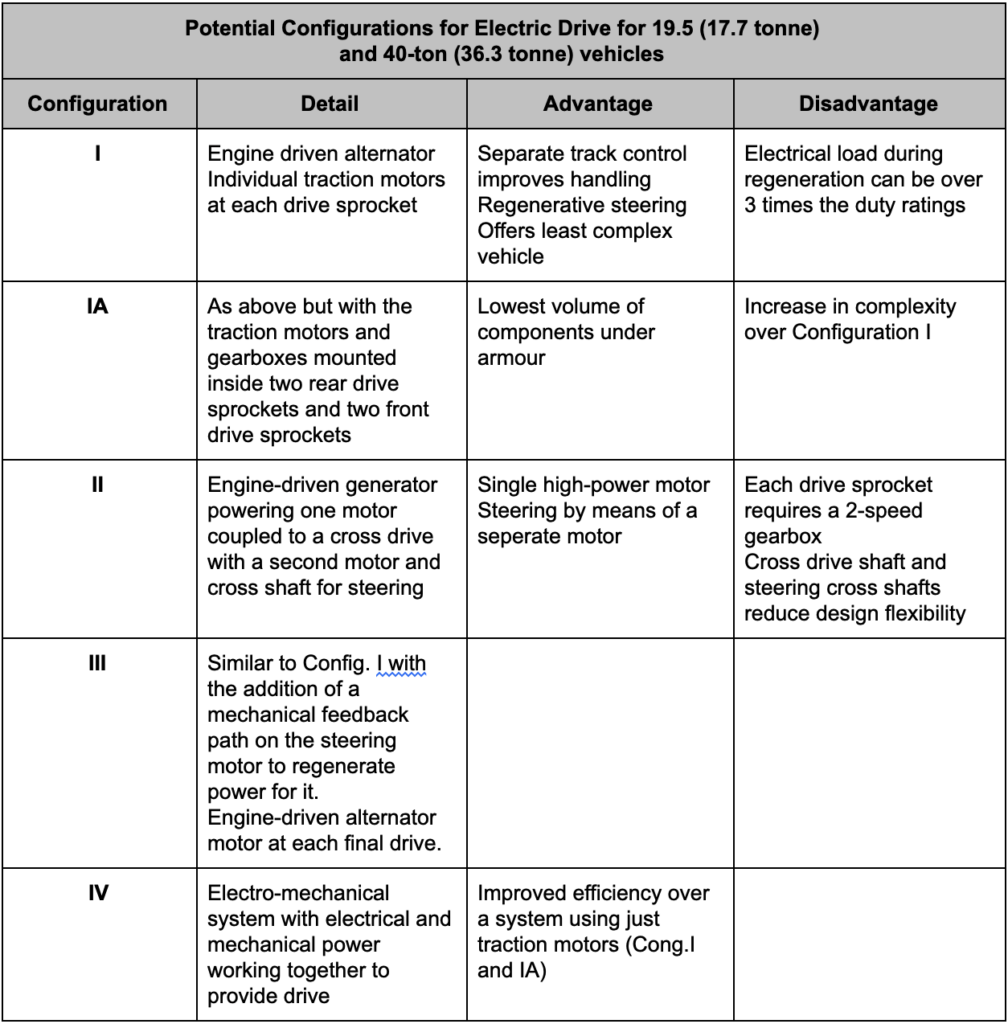
40-ton (36.3 tonnes) vehicle Concepts
With four (five including one minor amendment) configurations being considered, the design task was simplified by the specification of the engines to be used. Although the AD-1000 advanced diesel engine generating 1,000 hp was selected, other options were considered across the 19.5 ton (17.7 tonnes) and 40-ton (36.3 tonnes) projects for alternative forms of power. However, in the end, other than the possibility of switching to a petrol-turbine the existing diesel engines were the only technology mature enough to be considered.
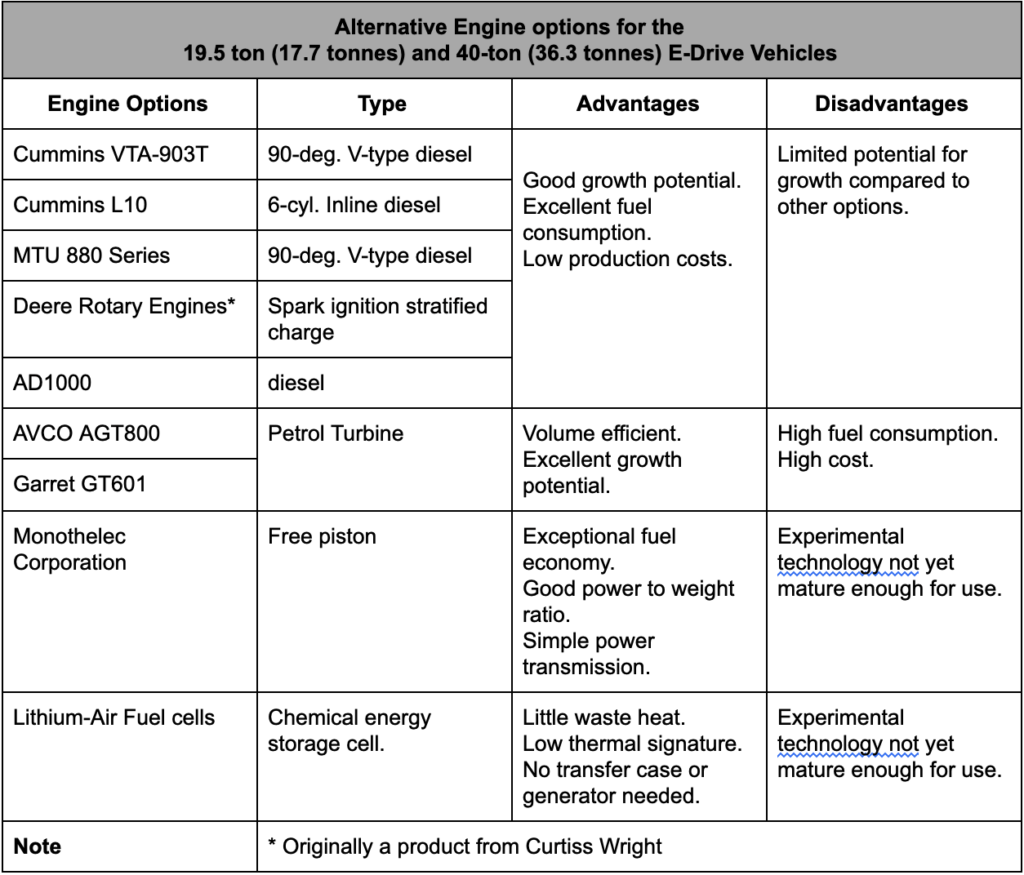
Each design was identified by concept number followed by a design number, for example ‘I-3’’ was Configuration 1 Design 3, whereas II-4 was Configuration 2 Design 4, and so on. Vehicle concepts selected to go forward from theoretical design to a drawing stage were all allocated a drawing number starting AD-8432-xxxx.
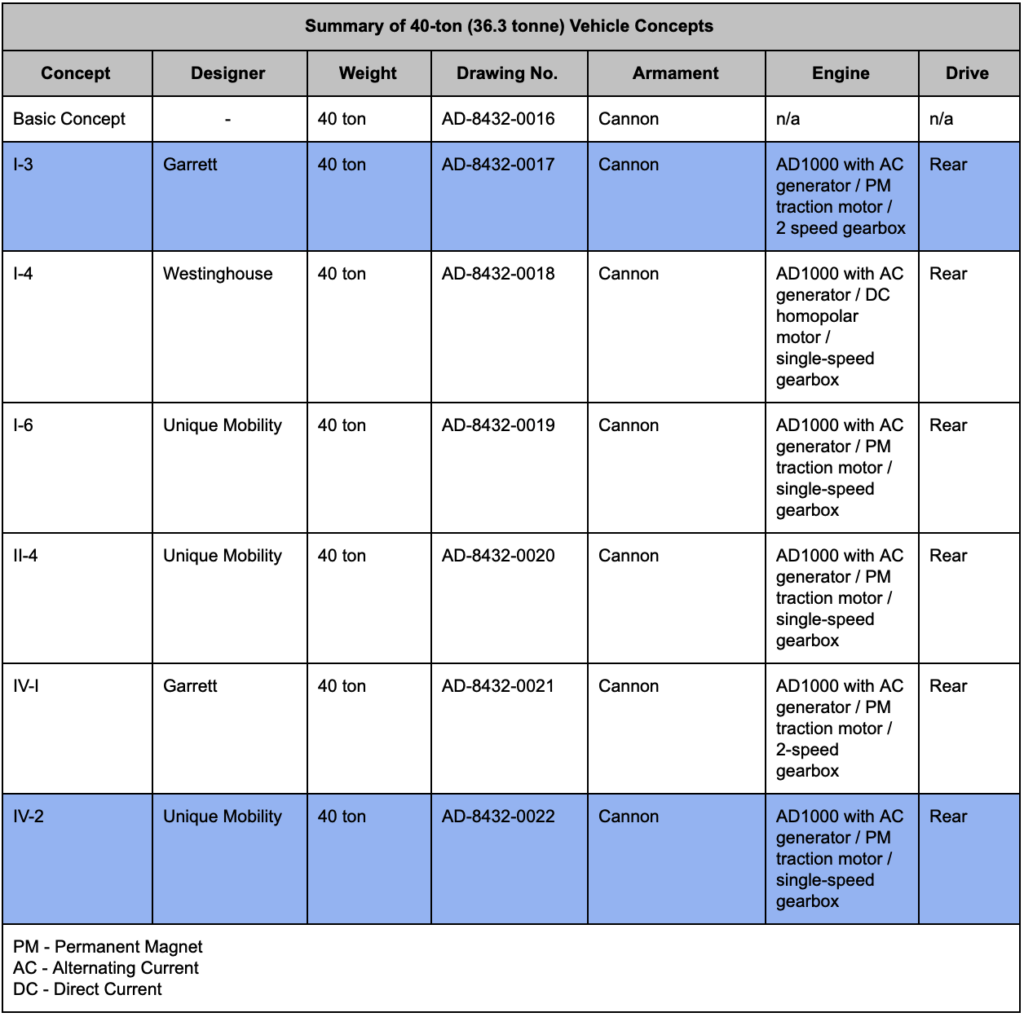

For the 40-ton (36.3 tonnes) concept, just two candidates were identified for further study – these were I-3 and IV-2. I-3 was designed by Garret and used a larger version of the same system as I-10 for the 19.5-ton (17.7 tonne) vehicle. The second was IV-2 from Unique Mobility which used scaled-up versions of the dual-path AC permanent magnet system it had proposed for the 19.5-ton (17.7 tonne) IV-2 concept.
Garret Concept I-3 40-ton (36.3 tonnes) Application
The drive system for the 40-ton (36.3 tonnes) vehicle application was the same as that of the Garret I-10 19.5 ton (17.7 tonne) vehicle, namely that it used two different paths for the delivery of automotive power, one mechanical and one electrical. The electrical system alone delivered power for speeds from 0 to 15 mph (24 km/h) and, when more power was needed to go above that, the mechanical system was unlocked and coupled to the electrical system. The control unit then controlled the power between these two units.
The electrical power was provided by a permanent magnet AC generator driven by the engine rectified to DC and then inverted in order to provide power to the traction motors. The generator was an oil-cooled Garret-type rated at 400 hp and rotated at 18,000 rpm with 93.5% efficiency. The oil-cooled rectifier for this system operated at 685 Volts DC at 98% efficiency and connected to a 284 Volt AC inverter operating at 96% efficiency.






The traction motors used rare-earth metal magnets made from neodymium which removed the problem of the cobalt-type magnets as the US had adequate stocks of neodymium. The cost of 400 of these power units for the 19.5 ton concepts was estimated to be 1985 US$145,000 per unit (just under US$350,000 in 2020 values), but for the 40-ton (36.3 tonnes) concept, the cost would be around 1985 US$240,000 (over US$575,000 in 2020 values) as it used two traction motors for each final drive.
The Garret traction motors delivered 192 hp each and were able to operate at 200% for up to 30 seconds and deliver power to the final drive units which operated at a 4:1 reduction ratio.
Cooling was an important factor in all of the systems and calculations for the Garret systems (both I-10 for the 19.5 ton and I-3 for the 40-ton) were made. For the 40-ton (36.3 tonnes) vehicle, a maximum heat rejection of 8,737 BTU/Min (9,218 KJ/ Min) was needed.
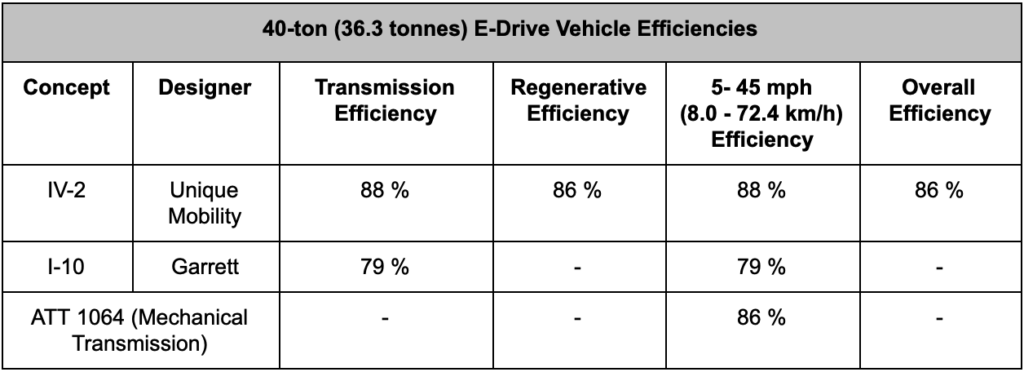
Analysis by GDLS across the 40-ton (36.3 tonnes) drive systems showed that there would be 855 hp available. The Garrett system was the better of the two for the 40-ton (36.3 tonnes) vehicle and was capable of forward acceleration from 0 to 20 mph (32.2 km/h) in under 7 seconds and reverse acceleration from 0 to 10 mph (16.1 km/h) in under 5 seconds.
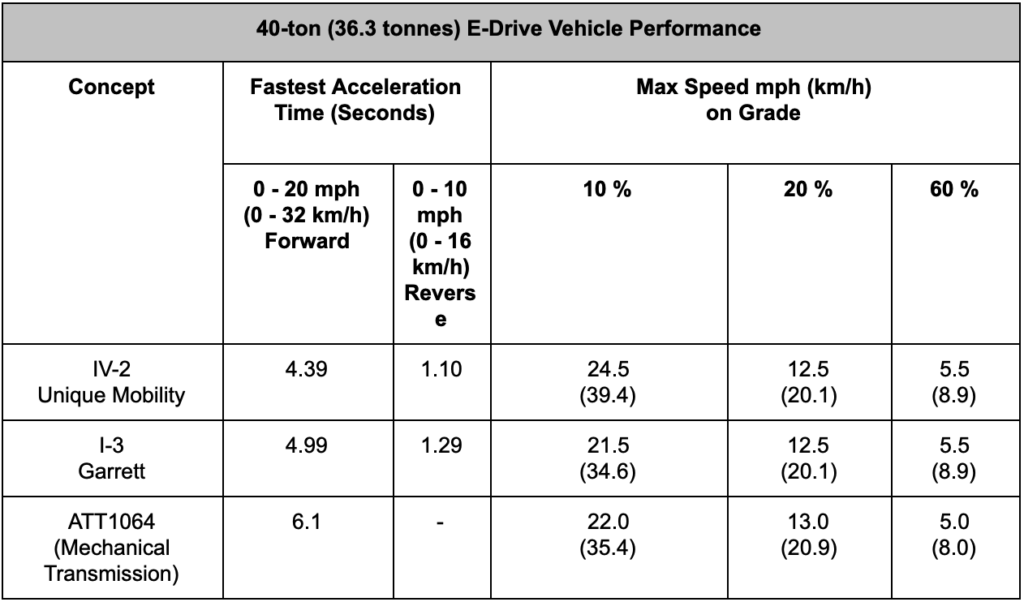
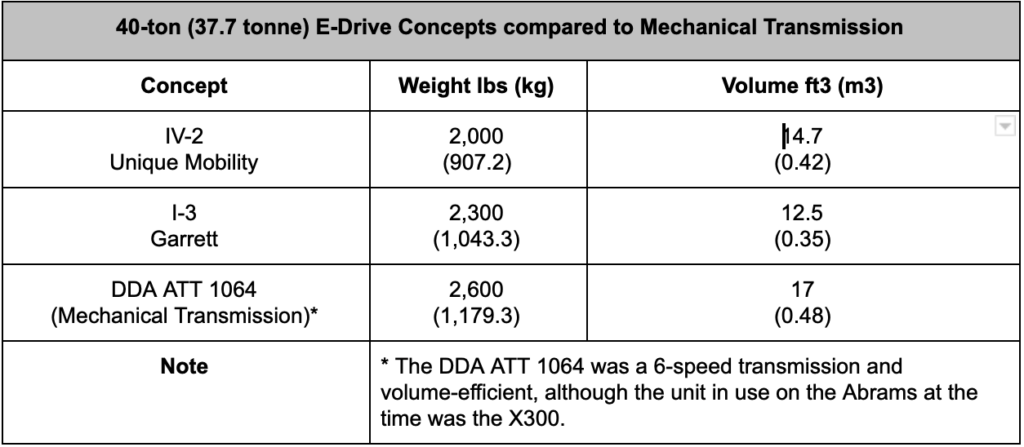
Conclusion
When this study was being done, the M1 Abrams was still a relatively new tank in service with the US military. The Soviet Union was still the major enemy to worry about with potential hordes of tanks able to swamp the armies of NATO in Europe still a constant threat in the minds of the NATO Generals. Lacking the option for a quantitative advantage over the Soviets, a qualitative advantage was sought and part of that grand quest was the goal for a tank with greater protection and more firepower than any Soviet contemporary. Just as the M1 Abrams had entered service to provide that advantage, the plan was simply to make an even better vehicle. Here, a turretless design with an autoloader that offered a small target and was capable of destroying any Soviet threat, and which also had the design flexibility offered by an electric drive, was seen as a promising approach. This vehicle was certainly not the only concept at the time to try and shed the weight of a turret on the Abrams or to increase its mobility and firepower. However, no electric drive main battle tank was ever produced along these lines, as the need for such an expensive system expired along with the Soviet Union.
Of the 38 possibilities for a drive system and layout for a 19.5 ton vehicle just three systems had been identified as being suitable for investigation or development; the Belgian ACEC DC system, the Garret AC permanent magnet drive, and the Unique Mobility dual-path AC permanent magnet drive system. Yet, for this heavier, 40-ton (36.3 tonnes) concept MBT design just two ideas made the cut, the Garret (I-3) using a larger version of the system proposed and selected as a potential system for the 19.5 ton (17.7 tonne) vehicle (I-10), and the Unique Mobility concept (IV-2), once more using a scaled-up version of its system proposed for the 19.5-ton (17.7 tonne) (IV-2) concept. Clearly from a logistics point of view and likely from a cost point of view as well any system selected for this 40-ton (36.3 tonnes) project should really have as much in common with the system on the 19.5-ton (17.7 tonne) project as well. Both projects, however, came to nothing and were dropped.
The potential advantages of an electric drive have still not yet been fully exploited by the US military or other tier 1 militaries around the world. With the prospect of freeing up additional internal volume, allowing a new configuration layout, and offering improved performance, a new generation of electric-drive AFVs is possible but unlikely as militaries opt to stick to traditional tried and tested propulsion systems.
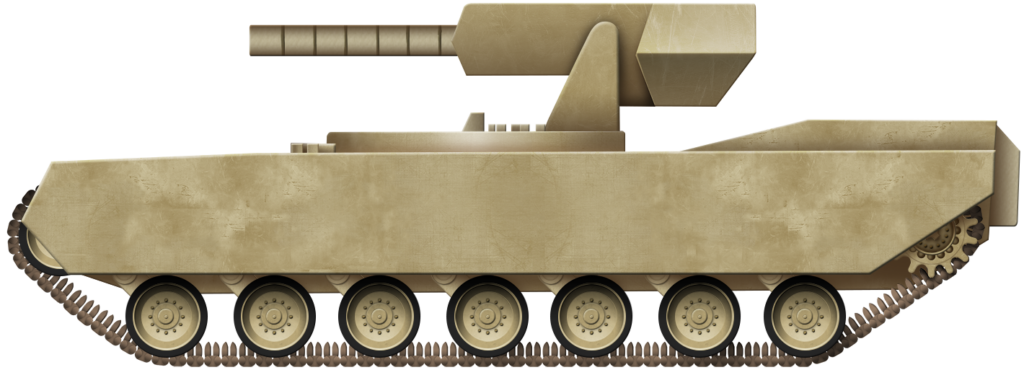
Sources
GDLS. (1987). Electric Drive Study Final Report – Contract DAAE07-84-C-RO16. US Army Tank Automotive Command Research, Development and Engineering Center, Michigan, USA
DiSante, P. Paschen, J. (2003). Hybrid Drive Partnerships Keep the Army on the Right Road. RDECOM Magazine June 2003
Khalil, G. (2011). TARDEC Hybrid Electric Technology Program. TARDEC
EDMBT specifications |
|
| Total weight, battle ready | 40 tons (36.3 tonnes) |
| Height | 70.5 “ (1.79 m) hull (raised engine deck) 104” (2.64 m) overall height |
| Length | 296” (7.52 m) overall length, 109.84” (2.79 m) from front wheel to rear (centers) |
| Width | 133” (3.38 m) wide (139” (3.53 m) with side skirts) |
| Track Width | 22.83” (0.58 m) wide |
| Track Length on Ground | 183.07” (4.65 m) |
| Crew | 3 – driver, commander, gunner (estimated) |
| Propulsion | 1,000 hp AD1000 Advanced Diesel engine |
| Speed (road) | 45 mph (72.4 km/h) |
| Armament | autoloaded 155 mm STAFF cannon with 15 rounds in autoloader plus 18 more in hull stowage, coaxial 7.62 mm machine gun |
| For information about abbreviations check the Lexical Index | |

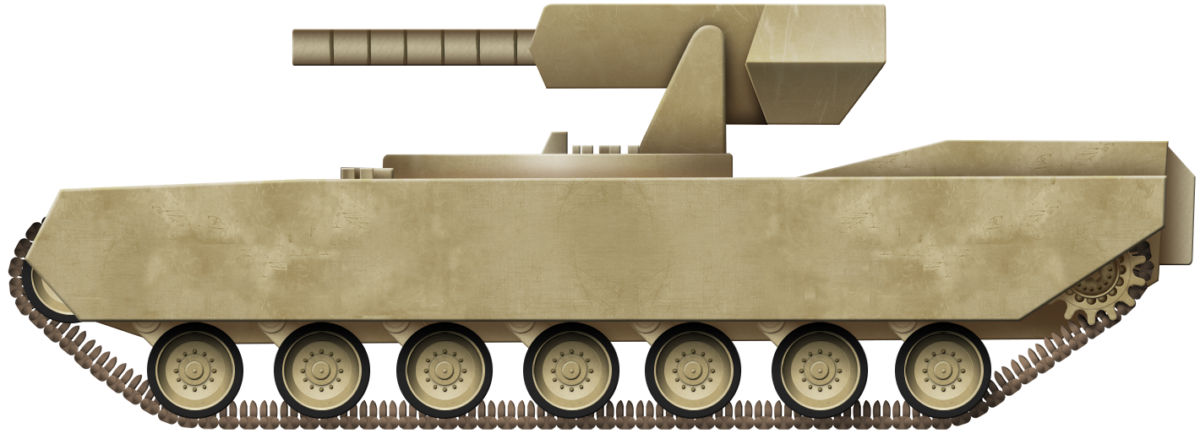
4 replies on “40-ton Electric Drive Main Battle Tank (E.D.M.B.T.)”
In the final analysis, I cannot find any company that can produce a tank or armored car worth a damn. You all spend money and get just BS in return. This stupid electric drive idea is going to kill us all. It takes fossil fuel to generate electricity. Has everyone gone stupid? You listen to these Democrats and they are all going to destroy this nation with this foolish green theory. Wind power does not produce one tenth of the power this nation needs and nor does solar. They are just gimmick ideas. People invest and loose their shirts on these crazy things. When is the White House, Secret Service, Congress etc going electric? Put an electric engine in one of the Presidents Limo’s.
Oh god, where to start.
First off, none of these companies were meant to make tanks or armored cars. They were making the electric transmission. The tank/IFV we illustrated were just meant to be templates that the electric transmissions were meant to power.
Second off, why would electric drives kill us all? These were still powered by internal combustion engines, they just had a different type of transmission, which was more flexible and had different capabilities than the normal mechanical ones.
No, it does not take fossil fuels to generate electricity. Solar, wind, nuclear and hydro power all generate electricity without needing fossil fuels. What I just listed is 36% of the total worldwide consumption of electricity, and that is with two technologies that have just begun to see investment and one that has been utterly neglected due to nuclear scares. Also, even if we continue to use fossil fuel to produce electricity, big power plants are far more effective, clean and cleanable than thousands of individual combustion engines in all our cars.
Also, please take your politics well away from our website. We don’t care if you’re a Republican or Democrat, take your politics away from us and go be crazy people someplace else. We want to discuss history, technology and logical things.
I can see electric tanks serving a niche in the military. If you want a tank that can travel 300 miles, you are going to stick with fossil fuels. But if you could get 50 miles on an electric tank, it would have some advantages.
1. Electric tanks don’t require oxygen. That would make them an excellent option for ultra high altitude mountain plateaus.
2. Electric tanks could hide in a lake or river for a very long period of time since they don’t require oxygen. Of course, you would need to build in an oxygen supply for the crew. Give the tank a periscope and you have a land sub.
3. You would want easily swapped out battery packs to extend range. Instead of a fuel truck following an electric tank, you would have a supply truck with extra batteries.
4. Electric tanks would be an excellent choice for guard duty, or anywhere that you have access to a power grid.
5. Electric tanks could also be a source of electricity for the military group.
6. Electric tanks would be far quieter than their oil based cousins.
I just did some rough math. On a 20 ton tank, you would probably need about 2 tons of batteries to have a range in the neighborhood of 50 miles. Swapping out 2 tons of batteries doesn’t seem feasible.